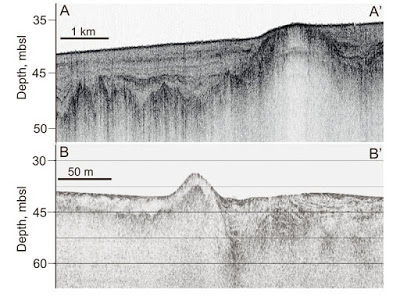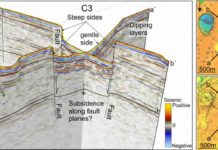
Pingos are spectacular landforms associated with permafrost in the Arctic. They are circular or elliptical formations protruding from the level ground of the tundra, and can be up to 60 meters high. In essence, they are huge lumps of ice covered with soil. Similar structures are now found strewn on the ocean floor in the Arctic shallow seas.
A recent study by Pavel Serov, PhD at Center for Arctic Gas Hydrate, Environment and Climate (CAGE), describes for the first time pingo like features offshore Siberia. The study suggests that they are forming because of the thawing of the subsea permafrost, and was published in Journal of Geophysical Research.
“Pingos are intensively discussed in the scientific community especially in the context of global climate warming scenarios. They may be the step before the methane blows out.” says Serov.
In the area of Yamal peninsula craters
Pingos came to public attention because of the story of the mysterious craters that suddenly appeared in Yamal Peninsula, Siberia. There is a theory that the craters may have been pingos. Beneath them the methane gas accumulated. The pressure built up under the ice lump due to the thawing of the permafrost and reactivated production of methane in the soil. The whole feature then blew up in one event releasing unknown amounts of gas.
Serov and colleagues focused on two subsea pingos that were identified offshore the very same area of the mysterious Yamal peninsula craters. The study shows how important methane accumulation is for the formation of subsea pingos. The study area lies in the shallow South Kara Sea, at approximately 40-meter water depth. Serov and colleagues, present in their paper a range of scenarios for the formation of the mounds, leading to potential blowouts of methane.
“Our question was: Are these mounds submerged terrestrial pingos? Or are they something different forming under marine conditions? One of the South Kara Sea pingos was leaking a lot of methane but where was the methane coming from?”
But as the CAGE study shows these newly discovered subsea pingos may be quite recent. This lends support to another hypotheses, the one that states that mechanisms that form pingos on land and mechanisms that form mounds on the ocean floor are completely different.
“The subsea-pingo like formations are significantly larger than the ones on land. Gas leakage from one of the ocean floor pingos offshore Siberia shows a specific chemical signature that indicates modern generation of methane. We suggest that the mound formed more recently, moving material physically upwards.”
A short glacial history lesson of Arctic shallow seas
During the ice ages of late Pleistocene, which started some 1,8 million years ago, Arctic soil froze. Beneath a thick layer of permafrost deposits of gas hydrate, an icy substance that contains enormous amounts of methane, formed. Because of the growing inclusion of sea water in the ice sheet build up the sea level dropped simultaneously, and these Arctic shallow seas became land. However, when the latest of the ice ages ended, some 19 000 years ago, the glaciers melted. The frozen shelves were flooded and what once were landmasses became the ocean floor.
Several million square kilometers of permafrost submerged. And, when submerged, it started melting. The temperature of the salty ocean water was warm and thus well above the freezing temperatures of terrestrial Siberia that maintain the permafrost. But we still find permafrost on the ocean floor. It acts as an impermeable cap over large deposits of methane beneath the presently warming ocean.
As permafrost extends into the ocean so do the pingos. They even appear in geographical proximities to the ones observed on land. An early study suggested that these pingos formed on land during the glacial period, and are therefore relics from the ice age, just like the Arctic subsea permafrost.
“The average ocean temperature is much warmer than Siberia, initially suggesting that the formation of subsea pingos could not be recent, as anticipated for pingos in cold Siberian environments. “ says CAGE director, prof. Jürgen Mienert, a co-author on the paper.
Thawing of permafrost and pressure from methane
But as the CAGE study shows these newly discovered subsea pingos may be quite recent. This lends support to another hypotheses, the one that states that mechanisms that form pingos on land and mechanisms that form mounds on the ocean floor are completely different.
“The subsea-pingo like formations are significantly larger than the ones on land. Gas leakage from one of the ocean floor pingos offshore Siberia shows a specific chemical signature that indicates modern generation of methane. We suggest that the mound formed more recently, moving material physically upwards.”
Dissociation of methane ice
On land pingos are mainly formed when the water freezes into an ice core under soil, because of the chilling temperatures of permafrost. However, subsea pingos, may be formed because of the thawing of relict subsea permafrost and dissociation of methane rich gas hydrates.
Gas hydrates are ice-like solids composed of among other things methane and water. They form and remain stable under a combination of low temperature and high pressure. In permafrost the temperatures are very low and gas hydrates are stable even under the low pressure, such as on shallow Arctic seas. Thawing of permafrost leads to temperature increases, which in turn leads to melting of gas hydrates, therefore, releasing the formerly trapped gas.
“ The methane creates the necessary force that pushes the remaining frozen sediment layers upward, forming mounds.” says Serov.
Quiet explosions beneath the Arctic shallow seas
Subsea pingos can potentially blow out, without massive attention, as was the case with the highly visible Yamal craters, but with massive expulsions of methane into the ocean. For petroleum companies these areas may pose a geohazard. Drilling a hole into one of these subsea pingos, can be not only expensive but also catastrophic. During a geotechnical drilling in the close by Pechora Sea, an industry vessel unknowingly drilled a hole into one of these mounds. It triggered a massive release of gas that almost sunk the vessel.
“We don´t know if the methane expelled from the subsea pingos reaches the atmosphere, but it is crucial that we observe and understand these processes better, especially in shallow areas, where the distance between the ocean floor and the atmosphere is short.” says Serov.
Video
Reference:
Pavel Serov, Alexey Portnov, Jurgen Mienert, Peter Semenov, Polina Ilatovskaya. Methane release from pingo-like features across the South Kara Sea shelf, an area of thawing offshore permafrost. Journal of Geophysical Research: Earth Surface, 2015; 120 (8): 1515 DOI: 10.1002/2015JF003467
Note: The above post is reprinted from materials provided by University of Tromso.










